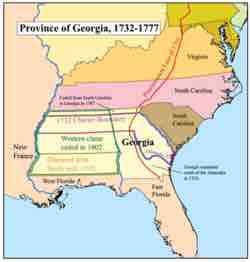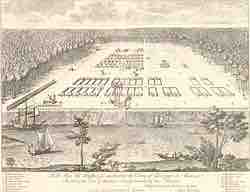The New Colony of Georgia
The Province of Georgia, also called Georgia Colony, was one of the southern colonies in British America and the last of the 13 original colonies established by Great Britain. George II, for whom the colony was named, granted the colony's corporate charter to General James Oglethorpe in 1732. An earlier grant to three Montgomery brothers was forfeited when they failed to establish a permanent colony, largely as a result of disease in the marshy area they chose to develop. In 1755, Georgia officially ceased to be a trustee colony and became a crown colony.

Georgia
A map of the Province of Georgia, 1732–1777.
The original charter specified the colony as the area between the Savannah and Altamaha rivers, up to their headwaters on the Ocmulgee River, and then extending westward "sea to sea." The area within the charter had previously been part of the original grant of the Province of Carolina, which was closely linked to Georgia. South Carolina had never been able to gain control of the area; however, American Indians had been forcefully pushed back from the Georgia coast after the Yamasee War, excepting a few villages of defeated Yamasee (who became known as the Yamacraw to distinguish them from the Yamasee in Florida and among the Creek). In practice, settlement in the colony was limited to the vicinity near the Savannah River. The western area of the colony remained under the control of the Creek Indian Confederation until after the American Revolutionary War.

Savannah, Georgia colony, early 1700s
An early drawing of Savannah, Georgia, from sometime in the early 1700s.
Oglethorpe's Role in the Georgia Colony
In 1733, General James Oglethorpe, who was a British member of Parliament, established the Georgia Colony as a solution for two problems. At that time, tension between Spain and Great Britain was high, and the British feared that Spanish Florida was threatening the British Carolinas. The Georgia Colony would act as a "buffer state" (border) or "garrison province" that would defend the southern part of the British colonies from Spanish Florida. Oglethorpe imagined a province populated by "sturdy farmers" that could guard the border and because of this, the colony's charter prohibited slavery. Additionally, Oglethorpe decided to establish a colony in the contested border region of Georgia and populate it with debtors who would otherwise have been imprisoned according to standard British practice.
Oglethorpe’s vision for Georgia followed the ideals of the Age of Reason, seeing it as a place for England’s “worthy poor” to start anew. To encourage industry, he gave each male immigrant 50 acres of land, tools, and a year’s worth of supplies. In Savannah, the Oglethorpe Plan provided for a utopia: “an agrarian model of sustenance while sustaining egalitarian values holding all men as equal.”
Oglethorpe’s vision called for alcohol and slavery to be banned. However, colonists who relocated from other colonies, especially South Carolina, disregarded these prohibitions. Despite its proprietors’ early vision of a colony guided by Enlightenment ideals and free of slavery, by the 1750s, Georgia was producing quantities of rice grown and harvested by slaves.

A new and accurate map of the Provinces of North and South Carolina
A map of the southeastern United States (Carolina, Georgia, Florida).